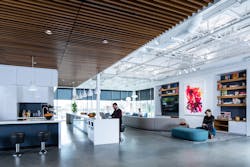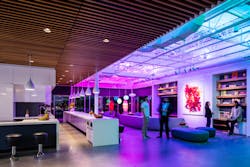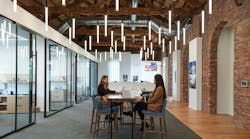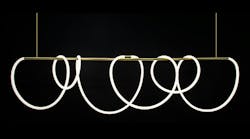To steal a phrase from the 1967 film The Graduate, I want to say one word: Connected! In the quest for buildings that are ever more sustainable and human-centric, cloud-connected lighting systems collect and communicate data to help architects and designers improve space use, increase energy efficiency, and add value for owners and tenants.
Connected systems are already part of our everyday lives. EV technology, for example, is changing today’s driving experience. Much of its appeal lies in the promise of on-demand support, future upgrades, and the assurance that the original investment is shielded from becoming obsolete the moment it’s driven off the lot.
Similarly, we invest in consumer hardware with the assurance that updates will be delivered frequently and easily over the air. Microsoft 365 and Apple iOS platforms are prime examples of technology that becomes more valuable and integral to our lives over time. The hardware purchase is just the tip of the iceberg. We count on it becoming more intelligent and capable with enhancements to software and firmware.
Architects and designers are asked to create spaces that meet the aesthetic and operational demands of building owners while supporting the evolving wants and needs of guests. Cloud-connected systems are critical tools for balancing differing priorities and adding smart technologies that take the building to the next level.
Connected lighting and shading systems are also vital investments that drive business decisions and help improve the occupant experience. A smart, connected lighting control system can be a data hub for integration with HVAC, plumbing, security, and maintenance systems with both immediate and long-term impact.
For example, with real-time actionable alerts, the operations staff at a hotel can address building system issues before they affect the guest experience. On-demand, remote factory support and control dashboards can help improve system uptime, particularly when the staff is managing multiple properties.
Technology is constantly updating and changing, and connected lighting solutions can be equally dynamic. They can flex easily and automatically to meet or exceed aesthetic and experiential expectations. They also can inform better space planning, improve comfort and convenience, and enhance real estate value over time. Integrating them into a design is limited only by imagination, budget, and time. Below are key factors to consider when choosing the right connected solution for a future project.
Qualities of a connected lighting and shading solution
Design flexibility. Each project is unique, so a lighting and shading system should expand design options while delivering the same integration and control capabilities for every project scale, from a single room to an entire building. A lighting system that works with a variety of luminaire solutions to deliver static white, tunable white, or full color control depending on the unique needs of the space enables design freedom. Lighting is a fundamental necessity, but a smart, connected lighting control system enables the power to create memorable experiences, evoke emotions, and craft an appealing, efficient space.
Individual fixture control options. Connected luminaire level lighting controls (LLLCs) magnify the power of LEDs, integrating the benefits of connected control systems directly into the fixture. LLLC-equipped fixtures can be individually controlled or digitally grouped to create lighting zones that meet the specified design vision and the specific customer needs—all without requiring complicated wiring schemes that limit design flexibility. LLLCs allow designers the freedom to evaluate and rethink lighting strategies throughout the design process, accommodate changing customer requirements, and refine settings by fixture, zone, or a combination of both.
Integrated daylight control. Beyond utility, light can be ethereal and magical. Natural daylight is one of the most coveted amenities in the built environment. Daylight harvesting strategies that increase comfort, promote views, reduce glare, and support energy reduction goals. In the morning, automated shades can open to let daylight illuminate the space, while electric lighting augments daylight as needed. As the sun moves throughout the day, electric lights can turn on or off, brighten, or dim while shades adjust to prevent uncomfortable glare and heat gain. As evening falls, shades may close against the cold or open to a beautiful exterior view with the aid of preset lighting levels that reflect the mood of the space.
Smart companion apps. Today, systems controls are not bound within the physical space. Apps give design, architecture, and facility teams the power and immediacy to make changes right from mobile devices anywhere, any time. Look for a lighting and shading system built to provide control in myriad applications—at the wall, from sensors and remotes, or via a mobile app—to enable the creative expression of light, drive operational improvements, and add value for the owner and the occupant.
Intuitive dashboard. Robust, analytical software can visualize and analyze complex information, such as occupancy and energy data, and organize it into intuitive reports that can inform business decisions, enhance well-being, drive operational improvements, and cement future system value.
Robust security. Cybersecurity is on everyone’s mind. Ensure that the chosen systems are up to the challenge. Look for third-party validation from organizations like ioXt, an alliance that promotes standardized security and privacy requirements and verifies manufacturer cybersecurity and software support policies for IoT products. Work with companies that communicate with IT teams throughout the process to deliver a system that prioritizes security.
Remote support and diagnostics. When lights do not turn on or off as expected, or a space doesn’t reach the desired set point, the occupant experience can quickly sour. A system provider must be poised to help work through these challenges from anywhere in real time.
Connected lighting systems can support design innovation, improve building performance, and deliver superior occupant experiences. For owners, a solution that provides continuous, automated software updates without prohibitive investments in new hardware can grow in value over time, setting a new standard that lighting control solutions can be endure for the life of a project.
Chris Udall is senior product manager of commercial at Lutron Electronics.









